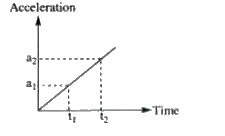The ratio of energy required to accelerated a car from rest to 20ms−1 to the energy needed to acceelerate from 20ms−1 to 40ms−1 is Solution in Telugu
1:1
1:3
1:2
1:4
The correct Answer is:B
Step by step video, text & image solution for The ratio of energy required to accelerated a car from rest to 20ms^(-1) to the energy needed to acceelerate from 20ms^(-1) to 40ms^(-1) is by Physics experts to help you in doubts & scoring excellent marks in Class 11 exams.
Topper's Solved these Questions
- BOOK - AAKASH SERIESCHAPTER - WORK -POWER-ENERGYEXERCISE - LECTURE SHEET (EXERCISE -III CONSERVATIVE AND NON CONSERVATIVE FORCES STRAIGHT OBJECTIVE TYPE QUESTIONS)13videos
WORK -POWER-ENERGY
- BOOK - AAKASH SERIESCHAPTER - WORK -POWER-ENERGYEXERCISE - LECTURE SHEET (EXERCISE -III CONSERVATIVE AND NON CONSERVATIVE FORCES INTEGER TYPE QUESTIONS)1videos
WORK -POWER-ENERGY
- BOOK - AAKASH SERIESCHAPTER - WORK -POWER-ENERGYEXERCISE - LECTURE SHEET (EXERCISE-I WORKDONE BY FORCE INTEGER TYPE QUESTIONS)1videos
WORK -POWER-ENERGY
- BOOK - AAKASH SERIESCHAPTER - VISCOSITY EXERCISE - Questions for Descriptive Answers3videos
VISCOSITY
- BOOK - AAKASH SERIESCHAPTER - WORK POWER ENERGYEXERCISE - EXERCISE - 361videos
WORK POWER ENERGY
Similar Questions
The work done in carrying a body from A to B is 20 J and from B to C is 15J. The work done in moving the body from A to C assuming the force involved in all the cases is conservative force is
01:54View SolutionA block of mass 2kg is moving with speed v0 towards a massles sunstretched spring (K=10N/m). It is found that for maximum speed v0=√6.4m/s, the block compresses the spring, stops at that position and does not return back. Friction coefficient at surface is μ=1x. Value of x is
02:07View SolutionAcceleration time graph of a particle is shown. Workdone by all the force acting on the particle of mass m in time interval t1 and t2, while a1 and a2 is the acceleration at time t1 and t2. Then find the value of a1 is ma21m21[t42−t41]. Then the value of n is
 05:32View Solution
05:32View SolutionAn iron sphere of mass 20×10−3 kg falls through a viscous liquid with terminal velocity 0.5 m/sec. Find the terminal velocity of another iron sphere of mass 54×10−2 kg.
03:16View SolutionIf →A+→B=→Rand2→A+→B is perpendicular to →B then
03:36View SolutionA body of mass 2kg starts from rest and moves with uniform acceleration. It acquires a velocity 20ms−1 in 4s.
The power exerted on the body at 2s is02:52View SolutionThe energy required to accelerate a car from 10 m/s to 20 m / s is how many times the energy required to accelerate the car from rest to 10 m /s
02:14View SolutionA car moving towards a vertical wall with a speed of 20ms^(-1) sounds a horn of frequency 765Hz .The wall is moving away from the car; their relative velocity of separation being 20ms^(-1) .Also there is a wind that is blowing in a direction from car towards the wall at a speed of 20ms^(-1) .The speed of sound in still air is 340ms^(-1) . The wavelength of sound waves returning towards the car after reflection from the wall is
02:00View Solution1kg ভর বিশিষ্ট একটি বস্তু 20m উচ্চতাসম্পন্ন একটি বাড়ির ছাদ থেকে নীচে পড়ল। বস্তুটির সর্বোচ্চ গতিশক্তি নির্ণয় করাে।
02:25View Solution1kg ভর বিশিষ্ট একটি বস্তু 20m উচ্চতাসম্পন্ন একটি বাড়ির ছাদ থেকে নীচে পড়ল। ভূমি থেকে 2m উচ্চতায় বস্তুটির গতিশক্তি ও স্থিতিশক্তি নির্ণয় করাে।
02:25View SolutionThe energy required to accelerate a car from rest to 10 ms^(-1) is W. the energy required to accelerate the car froms 10 ms^(-2) to 20 ms^(-1) .is:
03:05View SolutionThe energy required to accelerate a car from rest to 10ms-1 is W .the energy required to accelerate the car from 10ms-1 to 20ms-1 is
View SolutionA car moving with a velocity of 20ms−1 is stopped in a distance of 40m. If the same car is travelling at double the velocity, the distance travelled by it for same retardation is
View SolutionThe ratio of energy required to accelerated a car from rest to 20ms−1 to the energy needed to acceelerate from 20ms−1 to 40ms−1 is
04:06View SolutionThe ratio of energy required to accelerated a car from rest to 20ms−1 to the energy needed to acceelerate from 20ms−1 to 40ms−1 is
01:20View Solution

